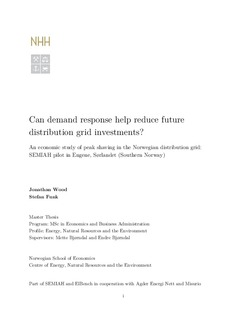Can demand response help reduce future distribution grid investments? : an economic study of peak shaving in the Norwegian distribution grid: SEMIAH pilot in Engene, Sørlandet (Southern Norway)
Master thesis
Permanent lenke
http://hdl.handle.net/11250/2453504Utgivelsesdato
2017Metadata
Vis full innførselSamlinger
- Master Thesis [4372]
Sammendrag
Steady increases in the number of new electronic devices and electrification of existing
technologies, such as electric vehicles, are creating new challenges in the electrical grid.
Electrification creates a higher demand for electricity, thus the volume transmitted via the
grid becomes larger and consumption peaks tend to increase. In addition, increasing the
energy efficiency of electronic devices often results in a higher nominal power. Consequently,
the shape of the load curve changes from a low and steady line to high and short peaks, for
example with an instant water heater versus a standard boiler. On the supply side,
increasing use of intermittent renewable sources is shifting generation from a continuous
and predictable pattern to a more volatile and unforeseeable one.
All the above developments increase the requirement for more capacity on the grid. One
peak hour per year decides on the grid investments for many years. Thanks to the
simultaneous digitalisation of power systems and metering, new markets and business
opportunities arise. One is demand response, where demand reacts to certain signals and
the flexibility gained is exploited for different purposes. For example, can household devices
react to reduce the peak consumption of a certain distribution grid area. Particularly in
Norway, capacity in distribution grids is becoming scarce and large investments are due.
This paper investigates the question of whether by controlling household devices it is
possible to reduce peak loads in the distribution grid and whether the process is economically
feasible. The paper is based on a pilot in Engene in southern Norway, through the European
Union funded research project SEMIAH. The examination of flexibility is achieved through
the control of hot water boilers. To set up a simulation framework for a flexibility market,
we studied in-depth the Norwegian electricity market, the load patterns of the transformer
in Engene and the power consumption behaviour of the pilot households.
The results show that boiler flexibility can be well used to shave peaks. Optimising the
household boiler consumption against market prices was less lucrative. The profitability of
a demand response technology was identified as the main challenge. If business models using
household flexibility will become economically feasible, it will depend a great deal on the
type of devices included in the demand response system, the information technology used
and the development of future power markets. Technology is evolving fast however and
many service companies are focusing on the topic. Thus, implementation of peak shaving
and other household flexibility concepts are likely to become a reality soon.
